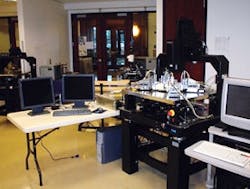Proactive on Prototyping
PROTOTYPE-TEST
This Cascade Microtech semiconductor test system is shown undergoing shop tests at Cascade’s offices. Cascade prefers to build and test prototypes and avoids customer site tests.
(Source: Cascade Microtech)
Electrical parameters and features such as grounding methods, EMI/RFI, PWM rise times and current leakage are primary factors in vendor evaluations. “We have found that the only effective way to evaluate these parameters is to install vendor components in a prototype and test,” adds Froemke. Cascade also uses test equipment from vendors such as Agilent, Keithley, NASA and JPL that are NIST-traceable to make electrical measurements. “We also keep a couple of Ph.D. physicists and EE types in a cage for some of the more esoteric measurements,” chuckles Froemke. “In many applications our machines are used to verify other machines’ measurements.”



